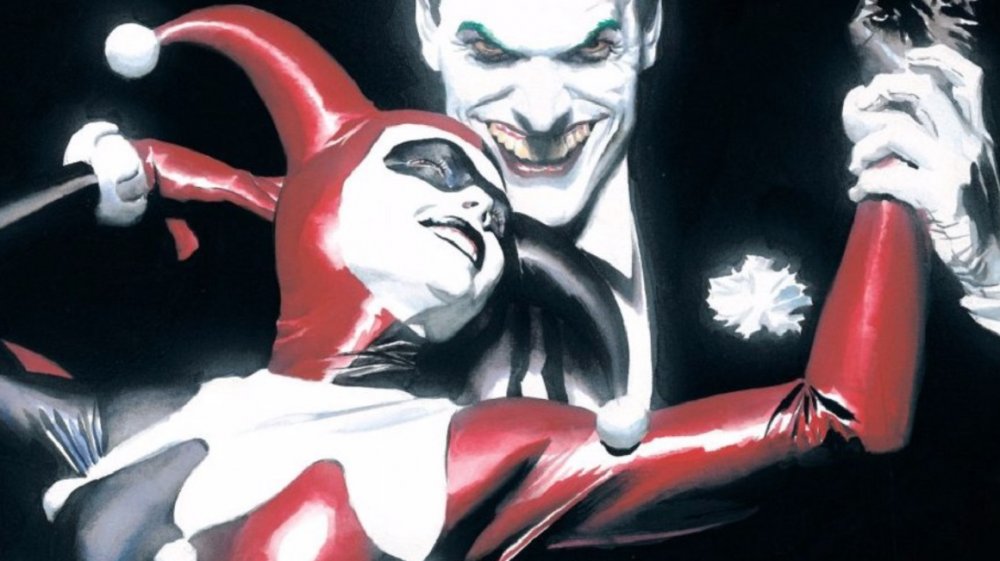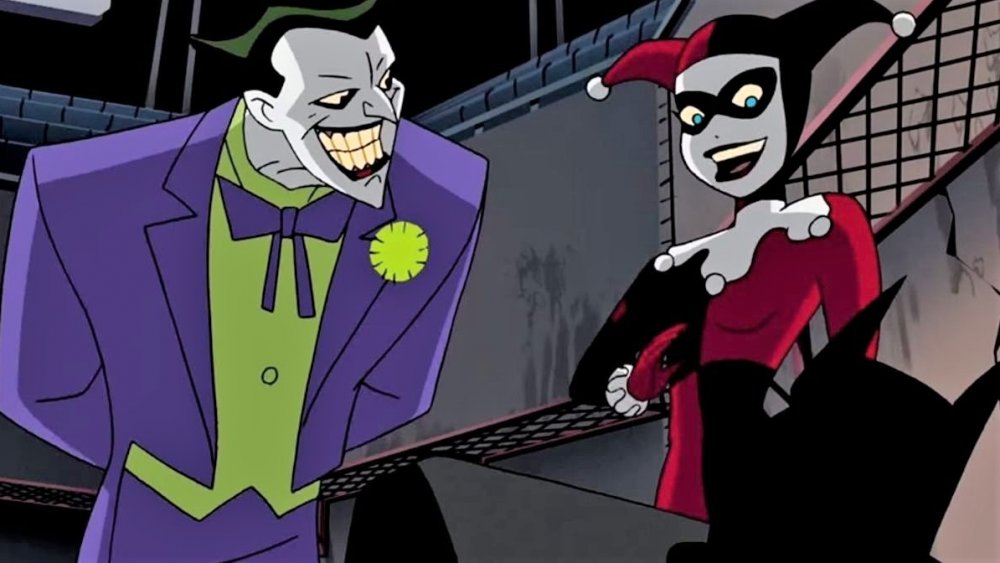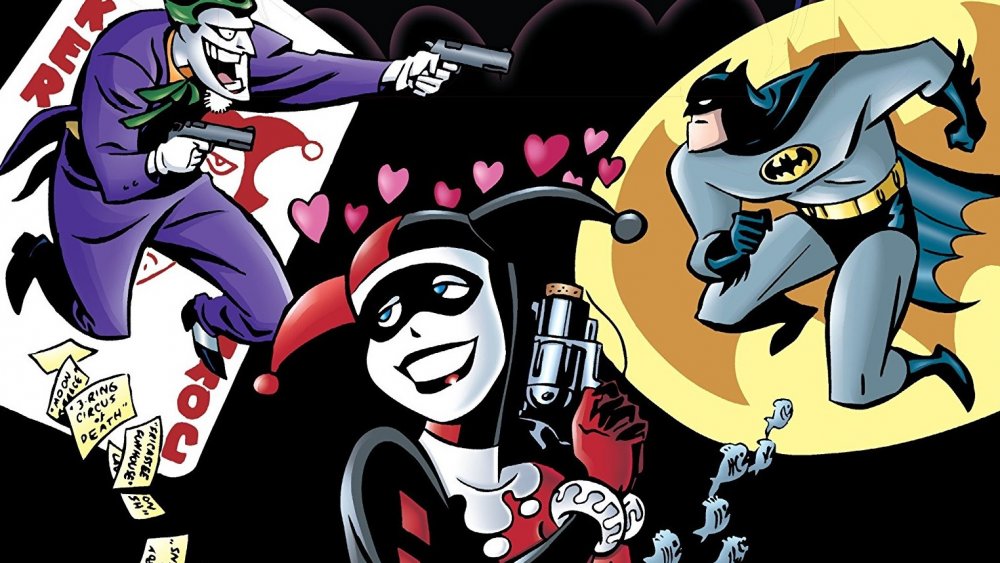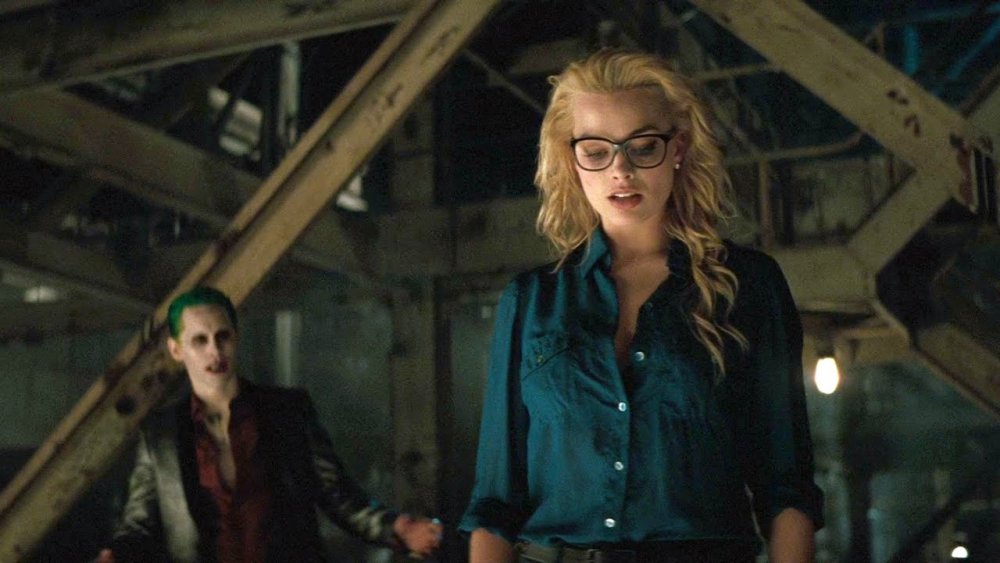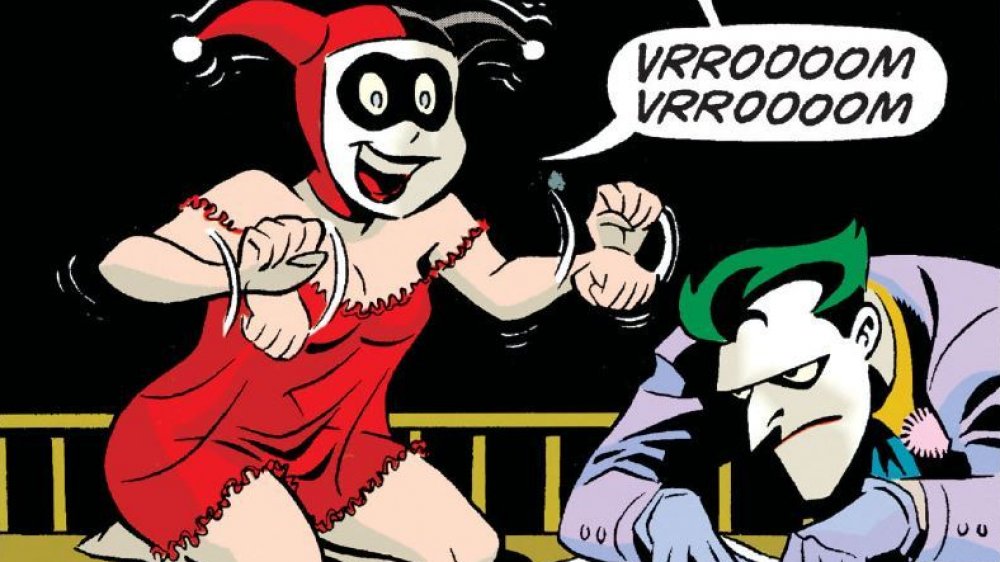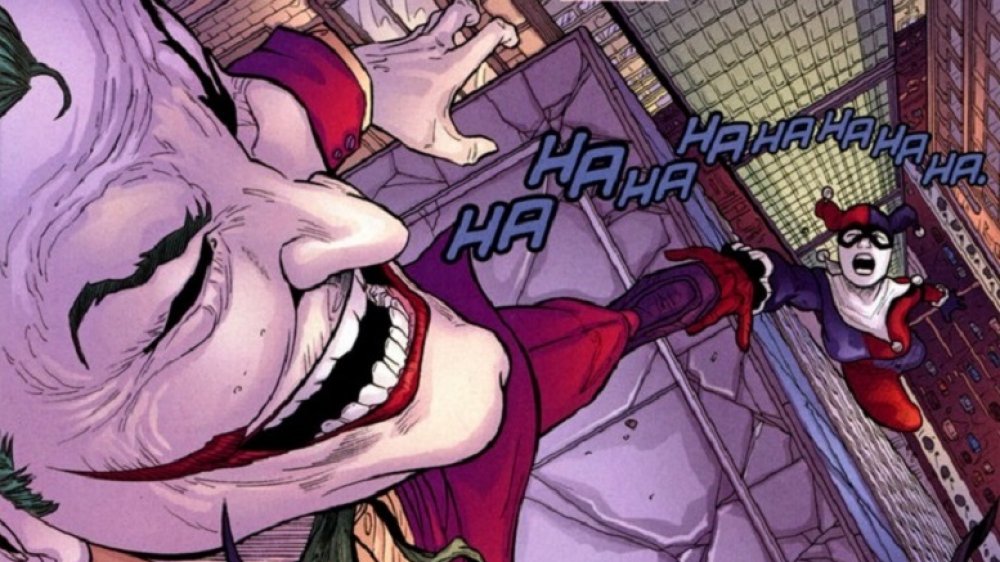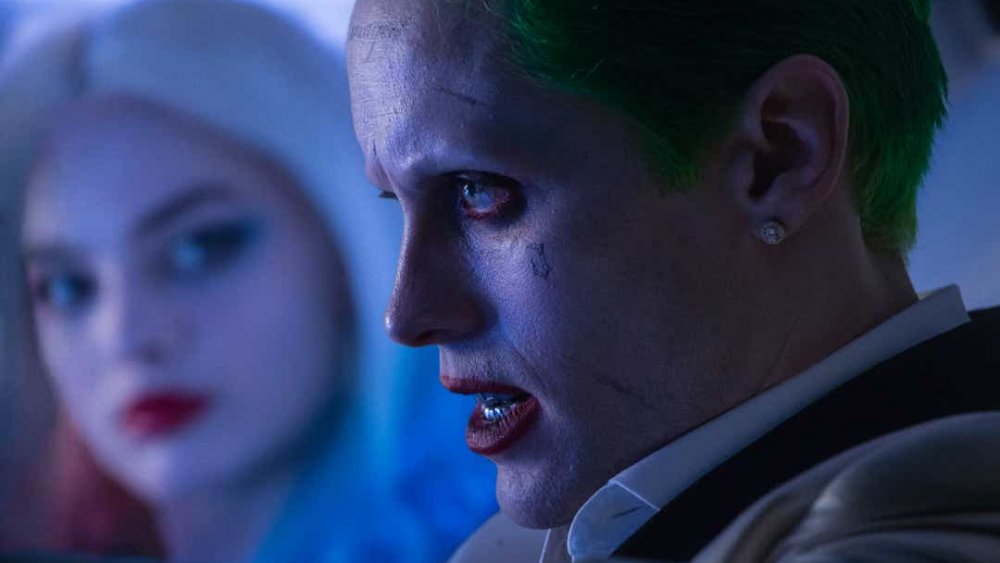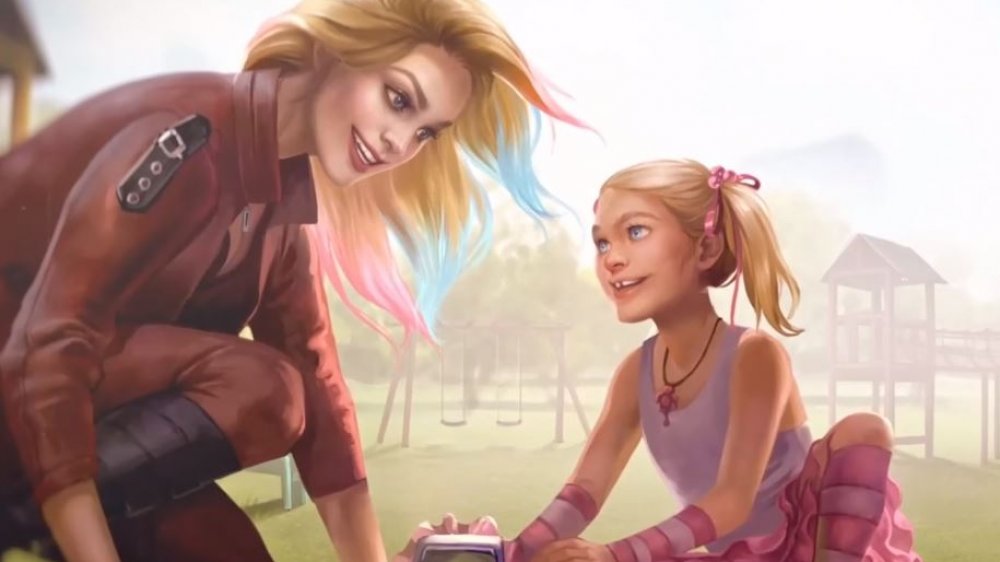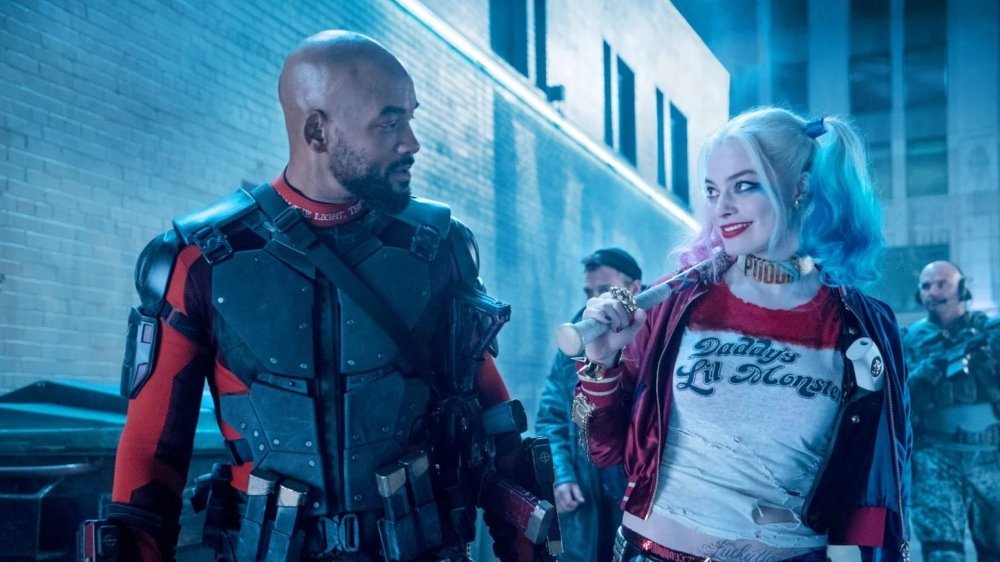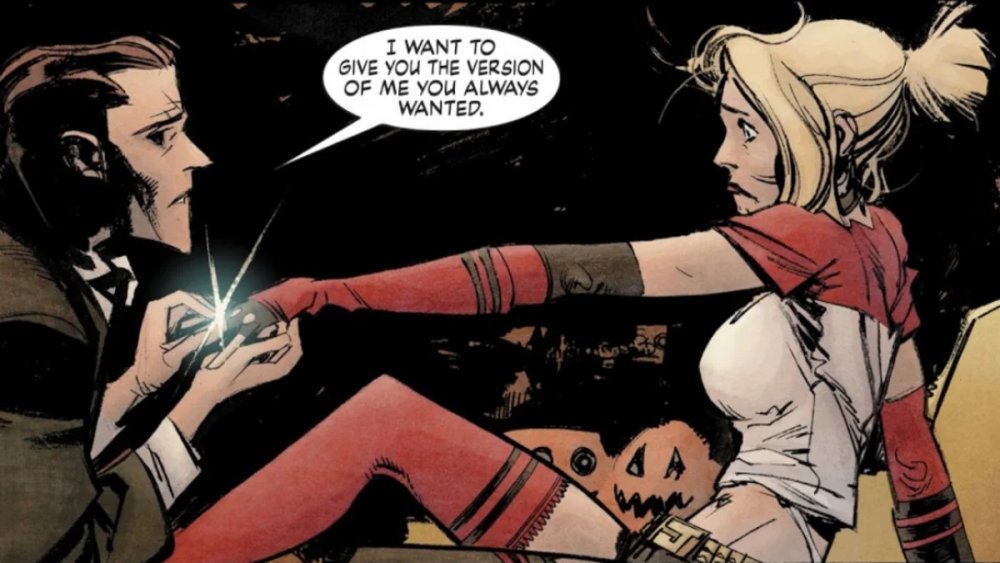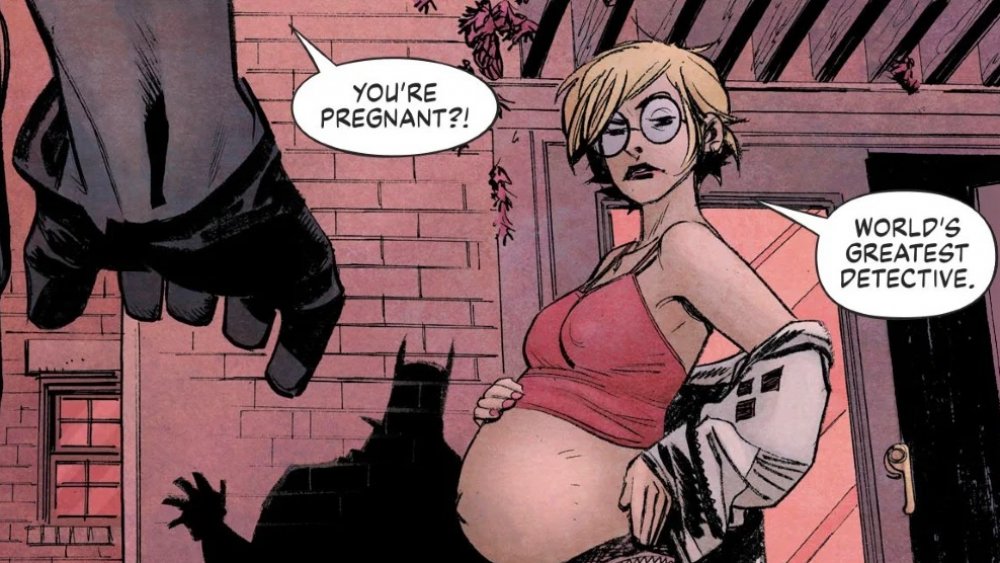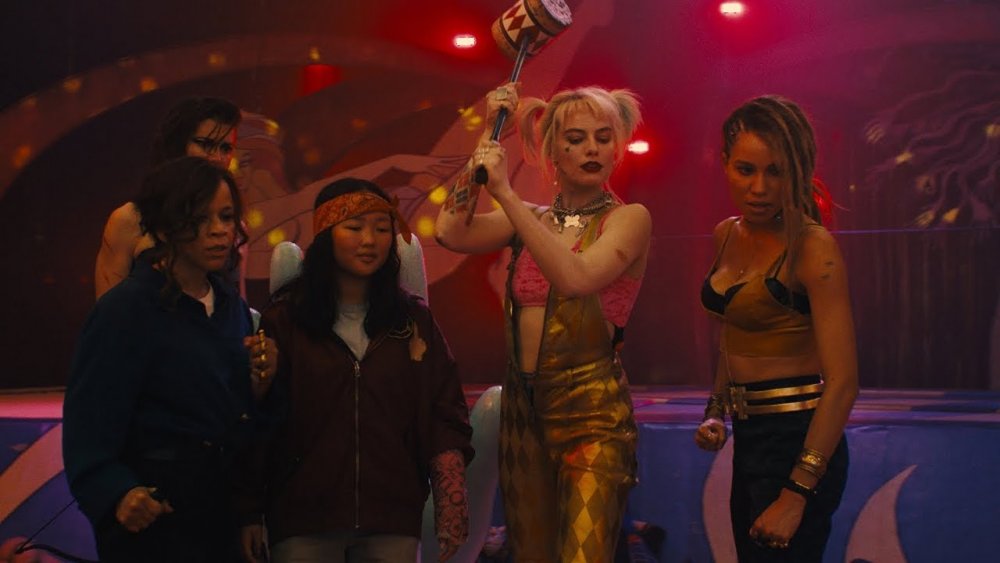The Truth About Harley Quinn And Joker's Relationship
For the longest time, Superman and Lois Lane stood head and shoulders above the rest as DC's most famous couple, but that's arguably no longer the case. Clark Kent has been romancing his Daily Planet colleague for more than 80 years now, but over the past few decades, a new power paring has emerged.
Harley Quinn's relationship with the Joker is a relatively new one. She's only been around since the '90s, but she's made a huge impact in her relatively short history. Speaking to Vulture, DC Comics publisher Jim Lee called Harley Quinn the "fourth pillar" of the company's publishing line (Superman, Batman and Wonder Woman being the other three), making her more important to them than the Clown Prince of Crime himself. The character has always been defined by her unhealthy attachment to the Joker, however, and for some, that's a huge problem.
When news broke that Margot Robbie was going to be portraying a live-action version of Harley Quinn in 2016's Suicide Squad, professionals expressed concern. Dr. Wind Goodfriend, principal researcher for the Institute for the Prevention of Relationship Violence at Buena Vista University, told MTV that current and former victims could be "re-traumatized" by the Joker's abusive behavior ... but Quinn has actually had it much, much worse in the comics. The Joker is often violent towards poor Harley, but she's become so much more than his victim over the years. Let's take a look at their colorful and extremely complicated relationship.
The relationship started in Joker's Favor
She's one of DC's most famous characters today, but Harley Quinn was never meant to be such a big deal. The Joker's crazy-in-love sidekick was created on a whim to fill a small role in "Joker's Favor," a 1992 episode of Batman: The Animated Series. Writer-producer Paul Dini came up with Quinn's persona when he saw actress Arleen Sorkin in an episode of long running soap opera Days of Our Lives. "I was home sick one day, and I was watching Days on TV, and she was playing a jester-type character in a fantasy sequence," Dini told Digital Spy. "I said, 'That's really kind of funny. Maybe I'll use some of that for the henchgirl character.'"
In her debut episode, Quinn (who quite clearly has a thing for her villainous boss from the get-go) sets off tear gas during a testimonial dinner for Commissioner Gordon at the Joker's behest. The little interactions between the two really struck a chord with viewers, and before long, the showrunners knew that they had a potential hit on their hands. Quinn was featured in more episodes and became the Joker's love interest, something that Dini and his co-creator, artist Bruce Timm, were initially wary of. "We didn't want to give Joker a girlfriend because it humanizes him, and we were really trying to stress how bizarre and creepy he could be," Timm told The New York Times. Ironically, Quinn's introduction would ultimately propel the Joker to all new levels of creepiness.
We got some more details in Mad Love
After featuring her in a handful of episodes, Batman: The Animated Series writer-producer Paul Dini found himself wanting to know more about this Harley Quinn. Viewers were responding well to the character, and Dini soon realized that Quinn needed a backstory worthy of the hype. The first thing he did was make a decision about who she was and where she came from. "Once we knew that, we sort of dropped little hints like breadcrumbs here and there," he told Digital Spy. "We said in episodes, 'Yeah, she used to be a psychiatrist...'" Fans got the full lowdown on the origin of Harley Quinn and the Joker's relationship in 1993, when the one-shot The Batman Adventures: Mad Love was released to critical acclaim.
Dini and Timm's Eisner Award-winning comic, which was set in the TV show's continuity, revealed exactly how Quinn became the Joker's girlfriend. In it, an ambitious psychiatrist named Dr. Harleen Quinzel takes a job at the notorious Arkham Asylum, where the Joker is being held. She tries to help him, but it's the Clown Prince of Crime who ends up getting inside her head. After the Joker escapes Arkham and is apprehended by Batman, a head-over-heels Quinzel transforms herself into a jester-like villain and stages a break-out. Thus, Harley Quinn (and her abusive relationship with the Joker) was born. "We sort of defined who Harley was in that comic," Dini said of The Batman Adventures: Mad Love. "I was very grateful the book got the response it did."
The chemical vat controversy
The origin of the Joker and Harley Quinn's toxic relationship was altered for the New 52, DC's 2011 revamp of its entire line. The changes were subtle on the surface, but for many Harley Quinn fans, the New 52 version of the character was totally different at the core. In Paul Dini and Bruce Timm's seminal one-shot The Batman Adventures: Mad Love, Harleen Quinzel falls in love with the Joker during their therapy sessions and, even though she was heavily influenced by the Joker, she joins his ranks willingly. That's not the case in the New 52.
In the updated origin story, the Joker pushes Quinzel into a vat full of the same chemical that bleached his skin white and turned him insane, and he does so against her will. For many, this fundamentally changed who Harley Quinn was as a character, altering her agency and the whole nature of her relationship with the Joker. "This made Harley appear as more of an unwilling victim than she had ever appeared before," one Outer Places piece on Quinn's origins claims. "In the New 52, she became a sociopathic, psychotic monster not totally by choice, but at least partially because of the Joker's cruelty."
David Ayer's Suicide Squad featured a mix of both origins, with Margot Robbie's Quinzel taking an oath to the Joker and jumping into the vat herself. The actress has gone on the record multiple times since then, saying she majorly regrets doing the scene because of how disgusting all that slime was.
Harley Quinn and Joker's relationship is no laughing matter
The Joker's relationship with Harley Quinn has been abusive from the very beginning. The Clown Prince of Crime routinely lashed out at Quinn in Batman: The Animated Series, and he would continue his physical and mental torment of his right-hand woman in the follow-up series, The New Batman Adventures. The final episode of the show, entitled "Mad Love" after the famous one-shot upon which it was based, contained several acts of violence that were particularly shocking for a show primarily aimed at children.
For example, the Joker pushes a lingerie-wearing Quinn off a desk at one stage, and when she tries to seduce him a second time, he kicks her out into the street. "Face it, Harl, this stinks," Quinn laments. "You're a certified nutso wanted in 12 states and hopelessly in love with a psychopathic clown." Later in the episode, Quinn goes behind the Joker's back and captures Batman herself, believing that they'll be able to live a happy life together with the Dark Knight out of the picture. An unimpressed Joker beats Harley and pushes her out of a window.
Quinn got a new, more revealing look for popular 2009 video game Batman: Arkham Asylum, but her relationship with the Joker stayed the same. In fact, the idea that the Joker is Quinn's abuser was drilled home during the game's dialogue by none other than the Joker himself. In the "Joker's Party" cut scene, the villain tells Batman that "slapping around Harley" is his hobby.
The Joker has tried to kill Harley Quinn on several occasions
The Joker often gets shockingly physical with Harley Quinn in the comics (he's done everything from pistol-whipping her to kicking her in the face), but from time to time, he goes one step further and actually tries to murder her. For example, Quinn's first appearance in the company's mainstream comic book continuity took place during Batman event No Man's Land. In the 1999 one-shot Batman: Harley Quinn (written by the character's co-creator, Paul Dini), the Joker tries to off his girlfriend using a rocket, not because she's too overbearing, but because he's becoming too attached to her for his liking. "I hate having those feelings," he tells her. "They're upsetting, confusing and worse, distracting me from getting my share of Gotham."
The Joker has tried to kill Harley Quinn on numerous occasions since then and in a variety of ways. He stood on her fingers as she dangled from the ledge of a skyscraper in one flashback scene from Peter Calloway and Andres Guinaldo's Gotham City Sirens #21, laughing his manic laugh as Quinn hung on for dear life. He shot his lover in the stomach with a gun he'd concealed in a bouquet of flowers at one stage, calling it a "wonderful start" to his day, and he's been known to conceal dynamite in bunches of flowers, too. Romance might not be dead, but Harley Quinn probably should be.
Warner Bros. tried to make their relationship more loving
David Ayer's Suicide Squad was a highly divisive movie, pulling in just shy of $750 million at the worldwide box office despite the fact that the vast majority of critics trashed it. If there was one thing that everyone could agree on, it was that Margot Robbie stole the show as Harley Quinn. Fears that the character was going to become a punching bag for Jared Leto's Joker turned out to be unfounded — although it took a last minute change of heart from the studio. It seems as though Warner Bros. got wise to a possible backlash and decided to make the Joker's relationship with his girlfriend a little less abusive.
According to Jared Leto, Warner Bros. cut enough Joker scenes out of Suicide Squad for a separate Joker movie. The extent of the cuts was revealed when a list of deleted scenes found its way onto the internet (via SlashFilm), and the reason for their axing also became abundantly clear — they were way too violent. In one unused shot, the Joker backhands Quinn across the face (footage of this slap being filmed was leaked online well before Suicide Squad hit cineplexes), and the crazy couple's big helicopter rescue scene was reportedly re-shot. In the final cut, Quinn falls from the chopper after it gets hit, but reports suggest that the Joker tossed Quinn out of the moving helicopter during a heated argument in the original cut.
They have a daughter named Lucy
If one thing's for certain about the Joker, it's that he's not father material. Even Harley Quinn has enough smarts to recognize this, which is why she went into hiding after falling pregnant with his child. Lucy Quinzel was introduced in the Injustice video games and featured in the tie-in prequel comics, which take place outside of DC's main continuity. They imagine a world in which Batman leads an insurgency against a regime headed by Superman, who became a tyrant after the Joker tricked him into murdering Lois Lane.
In 2014's Injustice: Gods Among Us: Year Two #13, Harley Quinn opens up about Lucy after a scrap with Black Canary. Quinn stops fighting when she sees her opponent vomit mid-battle and realizes that she's pregnant. The two engage in a heart-to-heart conversation, and Quinn reveals that she has a four-year-old daughter who's been living with her sister. "Mistah J didn't know about her," Quinn tells her shocked adversary. "I knew that wouldn't ... that he wouldn't ... his work was too important. He couldn't have a daughter." She went away for a year to give birth, and when she returned to the Joker's side, he didn't even acknowledge that she'd been gone.
Quinn claims in her Injustice 2 game ending (spoilers, she joins the Justice League) that she's happy being "crazy Aunt Harleen" to Lucy, but she's ultimately forced to tell her daughter the truth anyway when they're both kidnapped in the Injustice 2 comics.
Seeing other people
Most versions of Harley Quinn are dangerously obsessed with their respective versions of the Joker, but the Cupid of Crime has actually been involved with a number of other characters in her relatively short history. Quinn had a thing going with her Suicide Squad teammate Deadshot at one stage, something that was hinted at in the live-action movie. Things got super weird between the two in Suicide Squad Vol. 4 #7 when Quinn tied the sharpshooter to a chair and draped Joker's actual face (which he removed himself, because, Joker) over Deadshot's face, making for some pretty dark roleplay.
Quinn's relationship with Poison Ivy is a lot more uplifting. Fans started wondering if there might be some romantic feelings between them way back in the 1990s, when Quinn was first introduced. Ivy was always critical of Quinn's toxic relationship with the Joker in Batman: The Animated Series, and in the years that followed, their own relationship blossomed. DC confirmed that they were "girlfriends without the jealousy of monogamy" in a 2015 tweet, and in 2017's Harley Quinn #25, they shared their first main universe kiss.
In fact, 2017 was a pretty busy year for Quinn in terms of her love life. She kissed the Green Lantern and Lobo in the Harley's Little Black Book series, and the animated version of the character climbed into bed with Bat-family member Nightwing, much to the Dark Knight's disapproval. Their steamy scene in the animated feature film Batman and Harley Quinn left many fans in shock.
Harley Quinn finally got her true love story
Would Harley Quinn be able to have a normal relationship with the Joker if he wasn't completely deranged? That question was answered in DC Black Label limited series Batman: White Knight, in which she got the love story she always wanted with her Puddin'. Beginning in 2017, writer/artist Sean Murphy's eight-issue comic features a sane version of the Joker, cured by a miracle drug. His real name, it turns out, is Jack Napier, and he's hellbent on redemption. "I love Gotham, and it's time I paid her back for the debt owed by the Joker," Napier declares in the first issue. "The city deserved better than you, better than the Joker, and better than the Dark Knight. So I'm going to be her White Knight."
It's not just Gotham's forgiveness that he's after, however. The repentant villain also wants to make amends with his former lover, and he gets down on one knee to prove it. "I want to give you the version of me you always wanted," he tells a shocked Quinn ... who isn't the real Harley. It turns out the Joker replaced the original Quinn after she left him, and he forgot all about it. Fake Harley freaks out at the marriage proposal and attacks Napier, but the actual Harley (dressed in her classic red-and-black get-up) shows up and rescues him, kicking her doppelganger in the head for good measure. Romantic, right?
Quinn had to hide her pregnancy from the Joker, again
Harley Quinn kept the fact that she'd given birth to the Joker's child quiet in the Injustice comics, and she did the exact same thing in a recent sequel to Batman: White Knight. The first issue of follow-up series Batman: Curse of The White Knight dropped in July 2019, and at the time of this writing in 2020, it already has just as many WTF moments as its predecessor.
DC can get away with pretty much anything using the Black Label imprint, but even in this world, Harley Quinn and the Joker can't have their happily ever after. Jack Napier has reverted to his Joker persona by the beginning of Batman: Curse of The White Knight, though Harley Quinn is still Harleen Quinzel. With her sanity intact, she leaves the resurgent Joker. When she's later sought out by Batman for some advice on how to foil the Joker's latest plot, the World's Greatest Detective discovers why she's been completely out of the picture — she's carrying Napier's child.
In Batman: Curse of The White Knight #3, Quinzel gives in to Batman and agrees to interrogate a captured Joker alongside him, on the condition that he help her put up a crib first. The Dark Knight hoped that seeing a pregnant Quinzel would be enough to bring Jack Napier back to the surface, but he was wrong. The unlikely duo manage to reach Napier very briefly in the fifth issue.
The Fantabulous Emancipation of One Harley Quinn
The original subtitle quite clearly suggested that Harleen Quinzel would rid herself of the Joker in 2020's Harley Quinn: Birds of Prey, and Cathy Yan's film delivered. It wasn't exactly a smooth transition, however. Quinn (once again played to perfection by Margot Robbie) announces their split in typically insane fashion, blowing up Ace Chemicals. The plant was the birthplace of their toxic relationship, and destroying it sends a clear message to the Joker — but it also alerts the rest of Gotham to her newly single status.
Ewan McGregor's Roman Sionis (a.k.a Black Mask) is quick to pounce. He becomes dangerously obsessed with Quinn and attempts to bring her under his control. He almost gets his way, too. After being captured by the antagonist, Quinn retreats into her own head and convinces herself that Sionis respects her, using the same coping mechanism she resorted to while with the Joker. Only this time it doesn't last.
In the film's climax, Sionis tells Quinn that she's incapable of standing on her own two feet. "You need me," he tells her, but by this point she's figured out that this isn't the case. "Your protection is based on the fact that people are scared of you," she fires back. "I'm the one they should be scared of. Not you, and not Mr. J. 'Cause I'm Harley f****** Quinn." For now, at least, Quinn is an independent woman, both on the big screen and in print.
